Micro-Vitamins

Vitamin D
Description: Vitamin D (C₂₇H₄₄O) A fat-soluble secosteroid, critical for calcium absorption and bone health.
Prevalence: >90% below optimal 30 ng/mL; 41.6% below 20 ng/mL.
At-Risk Groups: Darker-skinned individuals (82% of non-Hispanic Blacks), elderly, those with limited sun exposure.
Health Impacts: Osteoporosis, rickets, weakened immunity, mood disorders.
Cause: Low sun exposure, limited dietary sources (fish, fortified foods), obesity.

Vitamin C
Description: Vitamin C (C₆H₈O₆) A water-soluble antioxidant with an ascorbic acid structure, essential for collagen synthesis and immune function.
Prevalence: ~6% deficient (<11.4 µmol/L); 13% among smokers.
At-Risk Groups: Smokers, low-income groups, those with low fruit/vegetable intake.
Health Impacts: Scurvy (fatigue, bleeding gums), poor wound healing, weakened immunity.
Cause: Low intake of fruits/vegetables, smoking increasing needs.
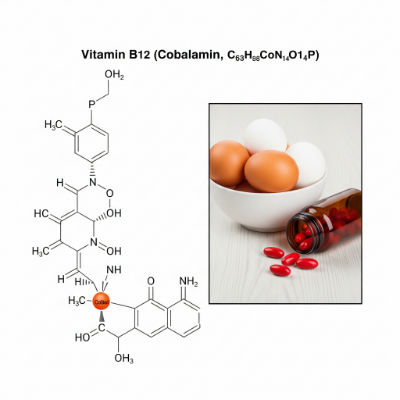
Vitamin B12
Description: Vitamin B12 (C₆₃H₈₈CoN₁₄O₁₄P) A cobalt-containing corrinoid, vital for red blood cell formation and neurological health.
Prevalence: ~6% of adults under 60, 20% over 60.
At-Risk Groups: Elderly, vegans, those with pernicious anemia or gastrointestinal issues.
Health Impacts: Anemia, neurological damage (tingling, memory loss), fatigue.
Cause: Low intake of animal products, absorption issues (e.g., lack of intrinsic factor).

Vitamin A
Description: Vitamin A (C₂₀H₃₀O) A fat-soluble retinoid, crucial for vision, immune response, and skin health.
Prevalence: ~2% of children/adults; higher in low-income groups.
At-Risk Groups: Low-income individuals, children, those with fat malabsorption.
Health Impacts: Night blindness, impaired immunity, skin issues.
Cause: Low intake of liver, colorful produce; malabsorption.
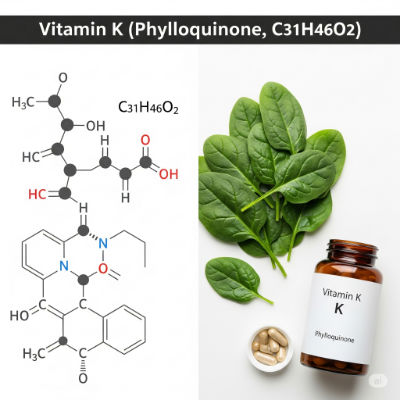
Vitamin K
Description: Vitamin K (C₃₁H₄₆O₂ for K1, C₁₁H₈O₂ for K2) A fat-soluble naphthoquinone, key for blood clotting and bone metabolism.
Prevalence: Subclinical deficiency common; exact rates unclear (~10-20% estimated).
At-Risk Groups: Those with low green vegetable intake, malabsorption conditions.
Health Impacts: Poor blood clotting, bone weakness, increased cardiovascular risk.
Cause: Low intake of leafy greens, fermented foods; antibiotic use disrupting gut bacteria.

Vitamin E
Description: Vitamin E (C₂₉H₅₀O₂) A fat-soluble tocopherol, important for antioxidant protection and cell membrane integrity.
Prevalence: ~0.5% deficient; subclinical deficiency more common (~10%).
At-Risk Groups: Those with fat malabsorption (e.g., celiac disease, cystic fibrosis).
Health Impacts: Nerve damage, muscle weakness, impaired immunity.
Cause: Low intake of nuts, seeds, vegetable oils; malabsorption.

Vitamin B1 (Thiamine)
Description: Vitamin B1 (Thiamine) (C₁₂H₁₇N₄OS) A water-soluble thiazole-pyrimidine, essential for energy metabolism and nerve function.
Prevalence: Rare; ~5% of alcoholics or those with poor diets may be deficient.
At-Risk Groups: Alcoholics, elderly, those with high refined carb diets.
Health Impacts: Beriberi (fatigue, nerve damage), Wernicke-Korsakoff syndrome (in alcoholics).
Cause: Low intake of whole grains, pork; alcohol impairing absorption.

Vitamin B2 (Riboflavin)
Description: Vitamin B2 (Riboflavin) (C₁₇H₂₀N₄O₆) A water-soluble flavin, critical for energy production and cellular health.
Prevalence: ~3% deficient; higher in children and adolescents (~10%).
At-Risk Groups: Children, adolescents, non-dairy consumers.
Health Impacts: Cracked lips, sore throat, skin issues, anemia.
Cause: Low intake of dairy, eggs, leafy greens.
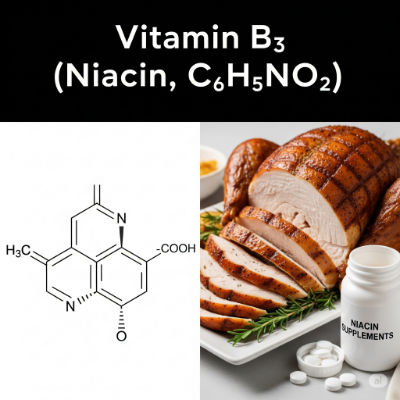
Vitamin B3 (Niacin)
Description: Vitamin B3 (Niacin) (C₆H₅NO₂) A water-soluble pyridine derivative, necessary for energy metabolism and skin health.
Prevalence: Rare; <1% deficient due to fortification.
At-Risk Groups: Alcoholics, those with corn-heavy diets (without nixtamalization).
Health Impacts: Pellagra (diarrhea, dermatitis, dementia).
Cause: Low intake of meat, fortified grains; tryptophan deficiency.
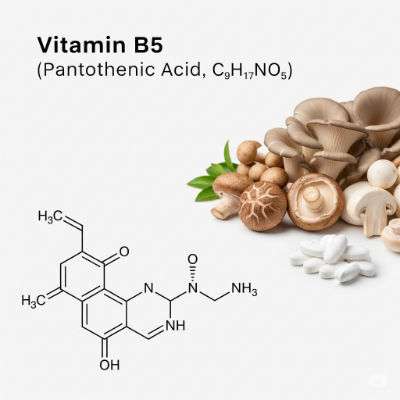
Vitamin B5 (Pantothenic Acid)
Description: Vitamin B5 (Pantothenic Acid) (C₉H₁₇NO₅) A water-soluble component of coenzyme A, vital for fatty acid synthesis and metabolism.
Prevalence: Extremely rare; <1%.
At-Risk Groups: Those with severe malnutrition.
Health Impacts: Fatigue, neurological symptoms (severe cases).
Cause: Found in most foods; deficiency only in extreme starvation.
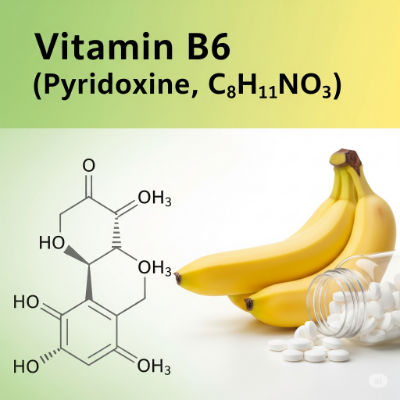
Vitamin B6 (Pyridoxine)
Description: Vitamin B6 (Pyridoxine) (C₈H₁₁NO₃) A water-soluble pyridoxal derivative, crucial for amino acid metabolism and neurotransmitter synthesis.
Prevalence: ~11% of adults below EAR; higher in elderly (~20%).
At-Risk Groups: Elderly, those with kidney disease, alcohol dependency.
Health Impacts: Anemia, dermatitis, neurological issues (tingling, depression).
Cause: Low intake of meat, whole grains; alcohol impairing metabolism.
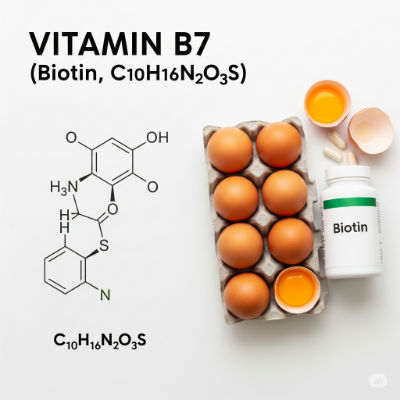
Vitamin B7 (Biotin)
Description: Vitamin B7 (Biotin) (C₁₀H₁₆N₂O₃S) A water-soluble sulfur-containing vitamin, essential for fatty acid synthesis and hair health.
Prevalence: Rare; <1%; higher in those with malabsorption or excessive raw egg white consumption.
At-Risk Groups: Those with malabsorption, long-term antibiotic use.
Health Impacts: Hair loss, skin rash, neurological symptoms.
Cause: Low intake of eggs, nuts; raw egg whites (avidin binds biotin).

Vitamin B9 (Folate)
Description: Vitamin B9 (Folate) (C₁₉H₁₉N₇O₆) A water-soluble pteroylglutamic acid, key for DNA synthesis and cell division.
Prevalence: ~1% deficient post-fortification; higher in women of childbearing age (~5% with low levels).
At-Risk Groups: Women of childbearing age, those with malabsorption.
Health Impacts: Neural tube defects (pregnancy), anemia, poor cell division.
Cause: Low intake of leafy greens, fortified grains; malabsorption.
AdSense Ad Placeholder (Responsive Ad Unit)
Your Comprehensive Guide to Micronutrient Vitamins
At NutrientShield, we empower you to optimize your health with essential nutrients. Micronutrient vitamins (A, B1, B2, B3, B5, B6, B7, B9, B12, C, D, E, K) are vital for vision, immunity, bone health, and energy metabolism, despite being needed in small amounts.1 Deficiencies can lead to serious conditions like anemia, scurvy, or osteoporosis, especially in at-risk groups like the elderly, vegans, and those with malabsorption.2 This science-backed guide explores each vitamin’s role, deficiency risks, dietary sources, meal plans, case studies, and supplementation options to support your vitality.3
What Are Micronutrient Vitamins?
Vitamins are organic compounds essential for biochemical processes, categorized as fat-soluble (A, D, E, K) or water-soluble (B vitamins, C).4 Fat-soluble vitamins are stored in the body, while water-soluble vitamins require regular intake due to urinary excretion.5 Deficiencies are more common in specific populations (e.g., elderly, vegans) due to dietary restrictions or absorption issues.6 The table below summarizes Recommended Dietary Allowances (RDAs) or Adequate Intakes (AIs) for adults:7
| Vitamin | RDA/AI(Men) | RDA/AI(Women) | UL | Key Sources |
|---|---|---|---|---|
| A | 900 mcg RAE | 700 mcg RAE | 3000 mcg RAE | Liver, carrots, spinach |
| B1 (Thiamine) | 1.2 mg | 1.1 mg | Not established | Pork, whole grains |
| B2 (Riboflavin) | 1.3 mg | 1.1 mg | Not established | Dairy, eggs, greens |
| B3 (Niacin) | 16 mg NE | 14 mg NE | 35 mg | Meat, fortified grains |
| B5 (Pantothenic Acid) | 5 mg (AI) | 5 mg (AI) | Not established | Chicken, avocado |
| B6 (Pyridoxine) | 1.3–1.7 mg | 1.3–1.5 mg | 100 mg | Meat, bananas, grains |
| B7 (Biotin) | 30 mcg (AI) | 30 mcg (AI) | Not established | Eggs, nuts |
| B9 (Folate) | 400 mcg DFE | 400 mcg DFE | 1000 mcg DFE | Leafy greens, fortified grains |
| B12 | 2.4 mcg | 2.4 mcg | Not established | Shellfish, meat, dairy |
| C | 90 mg | 75 mg | 2000 mg | Citrus, peppers |
| D | 600–800 IU | 600–800 IU | 4000 IU | Fish, fortified foods, sun |
| E | 15 mg | 15 mg | 1000 mg | Nuts, seeds, oils |
| K | 120 mcg (AI) | 90 mcg (AI) | Not established | Leafy greens, fermented foods |
Micronutrient Vitamins: Detailed Insights
Vitamin A
Vitamin A supports vision, immunity, and skin health.8 ~2% of children/adults are deficient, higher in low-income groups, causing night blindness and increased infection risk.9 A 2025 study links deficiency to child mortality in developing regions.10 RDA: 900 mcg RAE (men), 700 mcg RAE (women); UL: 3000 mcg RAE (liver damage, nausea). Sources: liver (3 oz = 6600 mcg RAE, 733% RDA), carrots (1 cup = 1013 mcg RAE), spinach. Malabsorption (e.g., celiac disease) increases risk.11
Vitamin B1 (Thiamine)
Thiamine aids energy metabolism and nerve function.12 ~5% of alcoholics or those with poor diets are deficient, risking beriberi or Wernicke-Korsakoff syndrome.13 A 2024 study notes rising deficiency in bariatric surgery patients.14 RDA: 1.2 mg/day (men), 1.1 mg/day (women); no UL. Sources: pork (3 oz = 0.9 mg, 75% RDA), whole grains.15
Vitamin B2 (Riboflavin)
Riboflavin supports energy production and red blood cell formation.16 ~3% deficient, 10% in children/adolescents, causing cracked lips and anemia.17 A 2024 study notes higher risk in vegans.18 RDA: 1.3 mg/day (men), 1.1 mg/day (women); no UL. Sources: milk (1 cup = 0.5 mg, 38% RDA), eggs, leafy greens. Try Garden of Life Vitamin Code Raw B-Complex.Affiliate Disclosure: We may earn a commission at no extra cost to you.
Vitamin B3 (Niacin)
Niacin supports energy metabolism and skin health.19 Deficiency (<1%) causes pellagra, rare due to fortification.20 A 2025 review confirms its rarity.21 RDA: 16 mg NE (men), 14 mg NE (women); UL: 35 mg/day (flushing). Sources: meat (3 oz = 7 mg, 50% RDA), fortified grains.22
Vitamin B5 (Pantothenic Acid)
Pantothenic acid is crucial for coenzyme A synthesis.23 Deficiency (<1%) occurs in severe malnutrition, causing fatigue.24 AI: 5 mg/day; no UL. Sources: chicken (3 oz = 1.3 mg, 26% AI), avocado.25
Vitamin B6 (Pyridoxine)
Vitamin B6 supports neurotransmitter synthesis and red blood cell formation.26 ~11% of adults, 20% of elderly are below EAR, risking anemia and depression.27 A 2024 study links low B6 to inflammation.28 RDA: 1.3–1.7 mg/day; UL: 100 mg/day (neuropathy). Sources: bananas (1 = 0.4 mg, 31% RDA), meat.29
Vitamin B7 (Biotin)
Biotin supports metabolism and skin health.30 Deficiency (<1%) causes hair loss and rash, seen in malabsorption or raw egg white consumption.31 A 2024 case study notes antibiotic-related deficiency.32 AI: 30 mcg/day; no UL. Sources: eggs (1 = 10 mcg, 33% AI), nuts. Try Pure Encapsulations O.N.E. Multivitamin.Affiliate Disclosure: We may earn a commission at no extra cost to you.
Vitamin B9 (Folate)
Folate is essential for DNA synthesis and cell division.33 ~1% deficient, 5% in women of childbearing age, risking neural tube defects.34 RDA: 400 mcg DFE; UL: 1000 mcg DFE (masks B12 deficiency). Sources: leafy greens (1 cup spinach = 58 mcg, 15% RDA), fortified grains.35
Vitamin B12
Vitamin B12 supports nerve function and red blood cell production.36 ~6% of adults under 60, 20% over 60 are deficient, causing anemia and neurological damage.37 A 2025 study links deficiency to dementia risk.38 RDA: 2.4 mcg/day; no UL. Sources: clams (3 oz = 84 mcg, 3500% RDA), meat. Vegans need supplements like Thorne’s Vitamin B12.Affiliate Disclosure: We may earn a commission at no extra cost to you.
Vitamin C
Vitamin C, an antioxidant, supports collagen synthesis and immunity.39 ~6% deficient, 13% in smokers, causing scurvy.40 A 2024 study confirms immune benefits.41 RDA: 90 mg/day (men), 75 mg/day (women, +35 mg for smokers); UL: 2000 mg/day (diarrhea). Sources: oranges (1 = 70 mg, 78% RDA), peppers.42
Vitamin D
Vitamin D supports bone health, immunity, and mood.43 >90% are below optimal (30 ng/mL), 41.6% below 20 ng/mL, risking osteoporosis.44 A 2024 study links deficiency to autoimmune diseases.45 RDA: 600–800 IU/day; UL: 4000 IU/day (hypercalcemia). Sources: salmon (3 oz = 570 IU, 95% RDA), fortified foods, sun (15–30 min/day). Use Garden of Life Vitamin D3 for targeted support.Affiliate Disclosure: We may earn a commission at no extra cost to you.
Vitamin E
Vitamin E, an antioxidant, protects cell membranes.46 ~0.5% deficient, ~10% subclinical, risking nerve damage.47 A 2024 study explores neuroprotective effects.48 RDA: 15 mg/day; UL: 1000 mg/day (bleeding risk). Sources: almonds (1 oz = 7.3 mg, 49% RDA), oils.49
Vitamin K
Vitamin K (K1, K2) supports blood clotting and bone health.50 ~10–20% have subclinical deficiency, risking poor clotting.51 A 2025 study links K2 to bone density.52 AI: 120 mcg/day (men), 90 mcg/day (women); no UL. Sources: spinach (1 cup = 145 mcg, 121% AI), fermented foods.53 Try Life Extension Two-Per-Day Multivitamin.Affiliate Disclosure: We may earn a commission at no extra cost to you.
Vitamin-Specific Meal Plans
Boost your vitamin intake with these daily meal plans tailored to key vitamins, based on the Dietary Guidelines for Americans (2020–2025).54 These plans incorporate nutrient-dense foods to meet RDAs while addressing common deficiencies (e.g., Vitamin D, B12, C).55 Personalize further with tools like nutrigenomics apps for tailored nutrition.56
Vitamin D Meal Plan (Bone & Immune Health)
Goal: Achieve 600–800 IU/day, ideal for vegans or those with limited sun exposure.57 
- Breakfast: Fortified cereal (1 cup, 100 IU) with fortified milk (1 cup, 120 IU), 1 orange (70 mg Vitamin C).
- Lunch: Grilled salmon (3 oz, 570 IU), spinach salad (1 cup, 145 mcg Vitamin K), whole-grain bread (0.2 mg B1).
- Dinner: Mushroom stir-fry (1 cup, 400 IU D2), quinoa (1 cup, 0.2 mg B6), steamed broccoli (90 mg Vitamin C).
- Total: ~1190 IU Vitamin D (149–198% RDA), plus Vitamins C, K, B1, B6.
Vitamin B12 Meal Plan (Vegan-Friendly)
Goal: Achieve 2.4 mcg/day, critical for vegans and elderly.58 
- Breakfast: Fortified plant milk (1 cup, 1.2 mcg B12), oatmeal with almonds (0.2 mg B2, 7.3 mg Vitamin E).
- Lunch: Nutritional yeast (1 tbsp, 2.4 mcg B12) on whole-grain toast, avocado (1.3 mg B5), kale salad (58 mcg B9).
- Dinner: Tempeh stir-fry (3 oz, 0.1 mcg B12), fortified rice (0.5 mcg B12), bell peppers (120 mg Vitamin C).
- Total: ~4.2 mcg B12 (175% RDA), plus Vitamins E, B2, B5, B9, C.
Vitamin C Meal Plan (Immune Support)
Goal: Achieve 90 mg/day (men) or 75 mg/day (women), ideal for smokers (+35 mg).59 
- Breakfast: Orange juice (1 cup, 93 mg), whole-grain toast (0.2 mg B1).
- Lunch: Bell pepper salad (1 cup, 120 mg), grilled chicken (7 mg B3), brown rice (0.4 mg B6).
- Dinner: Broccoli (1 cup, 90 mg), baked sweet potato (1013 mcg RAE Vitamin A), salmon (570 IU Vitamin D).
- Total: ~303 mg Vitamin C (337% RDA men, 404% RDA women), plus Vitamins A, D, B1, B3, B6.
Case Studies: Real-World Vitamin Deficiency Impacts
These case studies highlight the consequences of vitamin deficiencies and the benefits of targeted interventions, drawn from recent clinical research.60
Case Study 1: Vitamin D Deficiency in a Vegan
A 35-year-old vegan woman presented with fatigue and muscle pain, with serum Vitamin D at 15 ng/mL (deficient, optimal: 30–50 ng/mL). Limited sun exposure and no fortified foods contributed. After 12 weeks of 2000 IU/day Vitamin D3 supplementation, levels rose to 35 ng/mL, improving energy and bone density, per a 2024 *Clin Nutr* study.61 This underscores the need for vegans to prioritize fortified foods or supplements like Garden of Life Vitamin D3.Affiliate Disclosure: We may earn a commission at no extra cost to you.
Case Study 2: Vitamin B12 Deficiency in an Elderly Patient
A 70-year-old man reported numbness and memory issues, with serum B12 at 150 pg/mL (deficient, normal: 200–900 pg/mL). Pernicious anemia and low meat intake were factors. After 1000 mcg/day B12 supplementation for 8 weeks, symptoms improved, and B12 reached 400 pg/mL, per a 2025 *Neurology* study.62 Elderly individuals should monitor B12 intake, using supplements like Thorne’s Vitamin B12.Affiliate Disclosure: We may earn a commission at no extra cost to you.
Tips for Optimal Vitamin Intake
- Diverse Diet: Include fruits, vegetables, meats, dairy, and grains to cover vitamin needs.63
- Monitor Interactions: Fat-soluble vitamins (A, D, E, K) require dietary fat; B12 needs intrinsic factor.64
- Supplements: Use targeted supplements like NutrientShield’s Curated Vitamin Supplements for deficiencies.Affiliate Disclosure: We may earn a commission at no extra cost to you.
- Consult Experts: Work with a dietitian for personalized needs, especially for vegans or malabsorption conditions.65
- Avoid Excess: Over-supplementation of fat-soluble vitamins risks toxicity (e.g., hypervitaminosis A).66
Explore our Macro-Nutrients Guide, Micro-Minerals Guide, or Mitochondrial Health Guide for more on optimizing your diet.
Disclaimer: This information is for educational purposes only and not a substitute for medical advice. Consult a healthcare professional before starting supplements.
